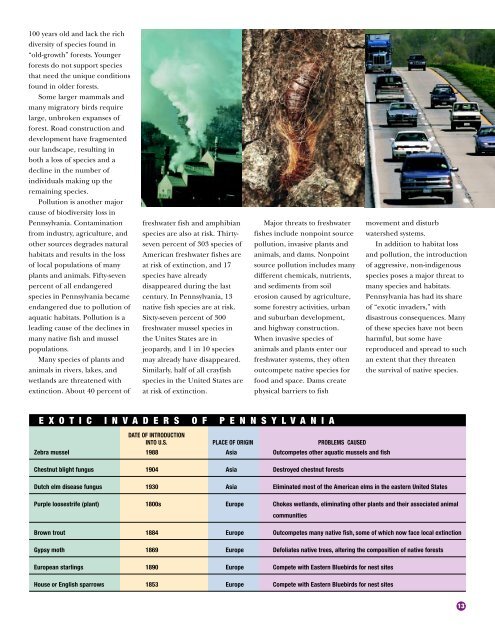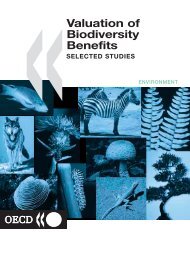Biodiversity: Our Living World-Your Life Depends on It!
Biodiversity: Our Living World-Your Life Depends on It!
Biodiversity: Our Living World-Your Life Depends on It!
Create successful ePaper yourself
Turn your PDF publications into a flip-book with our unique Google optimized e-Paper software.
100 years old and lack the rich<br />
diversity of species found in<br />
“old-growth” forests. Younger<br />
forests do not support species<br />
that need the unique c<strong>on</strong>diti<strong>on</strong>s<br />
found in older forests.<br />
Some larger mammals and<br />
many migratory birds require<br />
large, unbroken expanses of<br />
forest. Road c<strong>on</strong>structi<strong>on</strong> and<br />
development have fragmented<br />
our landscape, resulting in<br />
both a loss of species and a<br />
decline in the number of<br />
individuals making up the<br />
remaining species.<br />
Polluti<strong>on</strong> is another major<br />
cause of biodiversity loss in<br />
Pennsylvania. C<strong>on</strong>taminati<strong>on</strong><br />
from industry, agriculture, and<br />
other sources degrades natural<br />
habitats and results in the loss<br />
of local populati<strong>on</strong>s of many<br />
plants and animals. Fifty-seven<br />
percent of all endangered<br />
species in Pennsylvania became<br />
endangered due to polluti<strong>on</strong> of<br />
aquatic habitats. Polluti<strong>on</strong> is a<br />
leading cause of the declines in<br />
many native fish and mussel<br />
populati<strong>on</strong>s.<br />
Many species of plants and<br />
animals in rivers, lakes, and<br />
wetlands are threatened with<br />
extincti<strong>on</strong>. About 40 percent of<br />
freshwater fish and amphibian<br />
species are also at risk. Thirtyseven<br />
percent of 303 species of<br />
American freshwater fishes are<br />
at risk of extincti<strong>on</strong>, and 17<br />
species have already<br />
disappeared during the last<br />
century. In Pennsylvania, 13<br />
native fish species are at risk.<br />
Sixty-seven percent of 300<br />
freshwater mussel species in<br />
the Unites States are in<br />
jeopardy, and 1 in 10 species<br />
may already have disappeared.<br />
Similarly, half of all crayfish<br />
species in the United States are<br />
at risk of extincti<strong>on</strong>.<br />
Major threats to freshwater<br />
fishes include n<strong>on</strong>point source<br />
polluti<strong>on</strong>, invasive plants and<br />
animals, and dams. N<strong>on</strong>point<br />
source polluti<strong>on</strong> includes many<br />
different chemicals, nutrients,<br />
and sediments from soil<br />
erosi<strong>on</strong> caused by agriculture,<br />
some forestry activities, urban<br />
and suburban development,<br />
and highway c<strong>on</strong>structi<strong>on</strong>.<br />
When invasive species of<br />
animals and plants enter our<br />
freshwater systems, they often<br />
outcompete native species for<br />
food and space. Dams create<br />
physical barriers to fish<br />
movement and disturb<br />
watershed systems.<br />
In additi<strong>on</strong> to habitat loss<br />
and polluti<strong>on</strong>, the introducti<strong>on</strong><br />
of aggressive, n<strong>on</strong>-indigenous<br />
species poses a major threat to<br />
many species and habitats.<br />
Pennsylvania has had its share<br />
of “exotic invaders,” with<br />
disastrous c<strong>on</strong>sequences. Many<br />
of these species have not been<br />
harmful, but some have<br />
reproduced and spread to such<br />
an extent that they threaten<br />
the survival of native species.<br />
E X O T I C I N V A D E R S O F P E N N S Y L V A N I A<br />
DATE OF INTRODUCTION<br />
INTO U.S. PLACE OF ORIGIN PROBLEMS CAUSED<br />
Zebra mussel 1988 Asia Outcompetes other aquatic mussels and fish<br />
Chestnut blight fungus 1904 Asia Destroyed chestnut forests<br />
Dutch elm disease fungus 1930 Asia Eliminated most of the American elms in the eastern United States<br />
Purple loosestrife (plant) 1800s Europe Chokes wetlands, eliminating other plants and their associated animal<br />
communities<br />
Brown trout 1884 Europe Outcompetes many native fish, some of which now face local extincti<strong>on</strong><br />
Gypsy moth 1869 Europe Defoliates native trees, altering the compositi<strong>on</strong> of native forests<br />
European starlings 1890 Europe Compete with Eastern Bluebirds for nest sites<br />
House or English sparrows 1853 Europe Compete with Eastern Bluebirds for nest sites<br />
13












